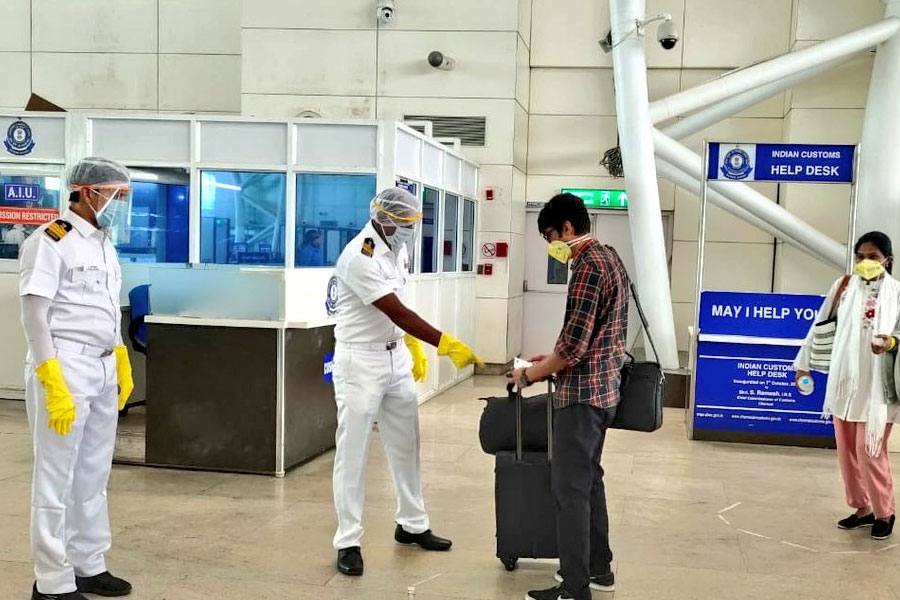Post-COVID, India is uniquely positioned to improve its exports
Dr Sunitha Raju, IIFT, explains why India has high potential to improve trade post-COVID, given prospects of faster recovery in advanced economies and high income elasticity of its exports. Moreover, India has the singular advantage of a large domestic market as compared to other developing economies, which can be leveraged to cover external demand.
However, she also cautions that in 2019 and in the preceding year, India’s export growth has been flat and in fact, declined. Therefore, increasing exports in the coming years would not only entail addressing the pre-COVID negative factors, but also effectively positioning Indian exports in advanced countries.

The ongoing COVID-19 crisis has brought in disruptions on many fronts – trade being no exception. IMF (World Economic Outlook, October 2020), World Bank (Global Economic Prospects, June 2020) and WTO (Trade Forecast, October 2020) have analysed and made projections on the impact of COVID-19 on world GDP and trade over the next two years. Global GDP/output is likely to decrease by 4.4% and trade flows by 9.2% in 2020. These aggregate projections do not address country specifics and therefore need a closer look, particularly from an India perspective.
COVID: A brief snapshot
To address this unprecedented health crisis, countries enforced complete lockdowns, which brought all economic activity to a standstill. The immediate economic implication of this measure is contraction in production, fall in investment and subdued trade flows. The other economic effects include rise in unemployment, fall in consumer incomes, and thereby demand; covering both supply side and demand side effects of recession.
To address these economic difficulties, governments employed varying fiscal measures to expand social security measures including wage support, unemployment benefits & targeted cash transfers. Support for businesses included capital and liquidity coverage requirements, debt moratoria and government guarantees. These initiatives stressed the financial sector, especially with limited fiscal space, and increased the debt burden of developing countries like India. In addition to these, the pressure on developing health infrastructure and health security with resilient health systems became a priority.
Compared to the support initiatives of India and other developing countries, advanced economies had a much broader scope as the recovery from quarter 2 of 2020 was much higher. The gradual withdrawal of lockdown and the continuation of social distancing has added new costs to the business and trade. Aligning the production processes with the operational challenges made costs higher for business besides the delay.
Trade was also impacted due to stringent border controls and production delays. Steep rise in freight costs and delayed delivery of foreign sourced intermediate goods disrupted the existing supply chains. Together, all this implied not only higher trade and trade facilitation costs but also production costs. For this reason, COVID-19 triggered recession and brought in contraction not only in global output, but also in global trade flows. Under these conditions and given the uncertainty of recovery rates across countries (COVID-19 cases are still rising), the projections (as under optimistic conditions) detailed in the Table below can best be indicative.
GDP and exports projection
| Real GDP Growth (% change) | Exports Volume (% change) | |||||
| 2019 | 2020 | 2021 | 2019 | 2020 | 2021 | |
| World | 2.8 | -4.4 | 5.2 | – | – | – |
| Advanced Economics | 1.7 | -5.8 | 3.9 | 0.7 | -9.7 | 7.3 |
| Emerging Economics | 3.7 | -3.3 | 6.0 | -0.5 | -5.5 | 8.8 |
| India | 4.2 | -10.3 | 8.8 | – | – | – |
Source: Based on IMF data, 2020
Taking the baseline as 2019, the projections for 2020 and 2021 clearly point to a slow recovery, which varies significantly across country groupings. The global output and export recovery in 2021 is largely dominated by the recovery of advanced countries. Emerging market economies’ recovery is also uncertain. This would mean that these countries would go much beyond 2021 to reach the baseline figures of 2019.
India’s case is much more challenging because of much higher contraction in output and exports. Indian merchandise exports fell by 60% while services exports (largely IT) increased by 1% in 2020. As such, the current account balance, which was marginally positive by 0.3% of GDP in 2020, is projected to decline to -0.9% of GDP in 2021 and -2.5% of GDP in 2025. The surplus in capital account is largely debt-based/depletion in foreign exchange reserves, primarily due to the projected fall in FDI.
For developing Asia, capital account balance is US$ 199.7 billion in 2020 and US$ 63.1 billion in 2021. Surplus in capital account is primarily to finance the deficit in current account largely accounted by investment, external borrowings or adjustment in foreign exchange reserves. As per projections, FDI (net) is set to decline by US$ 128.8 billion in 2020 and US$ 140.2 billion in 2021 (IMF, P.185). For India, these trends imply a stronger role for government in investment, facilitation to support business, particularly the informal sector (SMEs), which accounts for 90% of manufacturing units.
Trade-Output Relations: Channels
Sustainability of GDP growth is possible with demand expansion. Although India has the advantage of a large domestic market, leveraging this for covering external market demand is an opportunity, which other developing Asian countries do not have. In the macroeconomic framework, one of the components of aggregate demand is net exports (exports–imports). If exports are more than imports, then foreign demand for Indian goods is higher than Indian demand for foreign goods.
When foreign demand increases, then output increases, leading to higher employment and incomes. The determinant of foreign demand is incomes of the importing country market, which makes it exogenous and cannot be influenced by interventions. This demand is also impacted by prices, which can be an outcome of higher efficiency and/or subsidies. The income elasticity gives us responsiveness of exports to changes in foreign income and the price elasticity gives us the responsiveness of importing country demand for exports with prices.

Image credit: https://bit.ly/2G6gIwR
UNCTAD has estimated India’s income and price elasticities for quantifying the effects of the 2008 financial crisis. From the estimated export demand function, price and income elasticities are derived after adjusting for real effective exchange rate (provides price competitiveness of exports in the importing country as well relative position against competitors) and GDP deflators (real income changes).
With no significant structural changes in composition and direction of Indian exports, we can safely use these estimates to predict the quantitative impact of COVID-19 on India’s exports. The estimated price elasticity for world (there are variations across country groupings) is -0.54, implying a decrease in price of 10%, the rise in exports will be 5.4%. The estimated income elasticity is 1.88 implying a 10% rise in incomes will lead to 18.8% rise in exports. The income elasticity for USA is 2.48.
India’s exports are more responsive to income changes than price changes. Juxtaposing these estimates with GDP forecasts in 2021, we can broadly conclude that since the recovery is faster and higher in world (than in India) and advanced economies, the potential for increasing exports is high for India.
However, it needs to be underlined that in 2019 and in the preceding year, India’s export growth has been flat, in fact, declined. Therefore, increasing exports in the coming years would not only entail addressing the pre-COVID negative factors but also effectively positioning Indian exports in advanced countries.
The sectoral impact of COVID-19 on trade flows has been brought by WTO and IMF. As per WTO analysis, merchandise trade declined by 21% (Q2, 2020), largely accounted by fuels and mining (-38%) and manufactures (-19%). Agricultural products declined by 5%. Amongst the manufactures, positive growth was observed in textiles, electronics and pharmaceuticals. However, the recovery, compared to the decline in Q1, was good in automotive, handbags and footwear, clothing, other chemicals, industrial machinery, telecom equipment (positive growth) and precision instruments. It may be noted that for most of these high recovery industries, India does have export competence.

Image Credit: https://bit.ly/3e7Fd9A
Based on PMI, 2020, the expectation of recovery is higher than average for India (IMF, P24). However, the services PMI is much lower for India, largely pointing to continued restrictions and social distancing. Although these trends indicate the positive effects of discretionary budget measures, the challenge for India is macro management. The real economy must be aligned with the financial market for transition to the smooth functioning of banking, stock market and foreign exchange market, which is necessary for managing the exchange rate, inflation and employment.
Besides these issues relating to trade flows post-COVID, another important challenge on the trade front is the anxiety of higher incidence of non-tariff barriers (NTBs). The concern of rising NTBs was prevalent much before the current crisis. With the declining tariffs under WTO, countries resorted to different NTBs to provide protection to their domestic industries. WTO agreements don’t make these standards mandatory but provide flexibility (guidelines) to the countries to choose their standards for health and safety concerns.
The various measures under Technical Barriers to Trade (TBT) and Sanitary and Phytosanitary (SPS) have increased with declining tariffs thereby underlining their protectionist objectives (UNCTAD, P 24). The estimated costs of NTMs is 15.3% largely on account of lack of harmonization, wide differences in regulatory approaches and domestic procedural obstacles. COVID-19 has underlined the importance of addressing these issues through regional/multilateral cooperation and mutual recognition agreements (MRAs) to strengthen a country’s obligation to provide safe, healthy and sustainable growth.
To conclude, COVID-19 has highlighted the challenges for India on many fronts. The priority should be to address under capacity utilization and restore production. The estimated output gap for 2020-21 is 8% and by 2022-23, it is likely to reduce to 3% provided necessary support is given to businesses particularly the informal sector. Facilitating digitization and upskilling will boost employment potential. At the same time, public investment in infrastructure and facilities should be increased to face new challenges. Overall, a structured policy frame is necessary to support growth targets. While the day to day uncertainties may necessitate deviations, focus should not be lost.
Dr. Sunitha Raju is a Professor at IIFT. She has 23 years of extensive experience in Education, Research, Policy formulation and Evaluation. Held the positions of Chairperson (ICCD), Chairperson (Research) and currently Chairperson (GSD). Her areas of expertise include Trade Policy Formulation & Evaluation, Trade modelling, Agricultural Policy Analysis, WTO rules & Regulatory framework, Free Trade Agreements, Survey Research, Performance Reviews, Training & Management Development Programmes.













Sound analysis. Capacity utilisation should be national priority now.
Excellent Analysis Madam, Digitization,upskilling,Supporing Sme sector will play major role in GDP and employment we believe in post covid and coming years.
Your analysis will encourage people to focus on his goal as focus should not be loss.